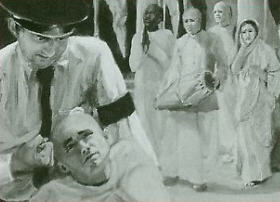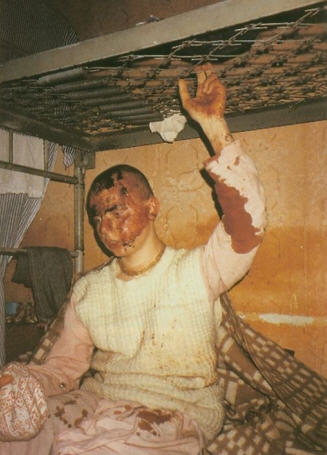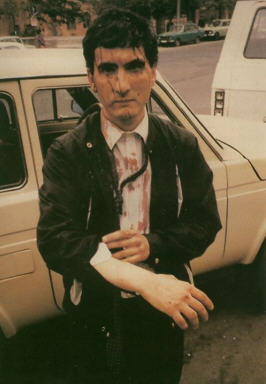From: Internet: premarnava.hks@iskcon.com
To: armenia_list@hare_krishna_list.voicenet.com
Bcc: Jayadvaita Swami (BTG)
Subject: Armenia
On April 18, 1995, at 3:00 P.M. (local time), twenty or twenty-five unknown men stormed into the ISKCON (Hare Krishna) temple in Yerevan [the capital of Armenia].

At the time of the attack seventeen people were present in the temple (eleven males, four females, and three children). The thugs were armed with automatic weapons, submachine guns, guns, metal rods, and metal chains. They arrived at the temple in three cars with no registration plates.
The intruders immediately started to severely beat all the people present, kicking them and hitting them with metal rods. After a short time the women and children were thrown out of the house, but the male members continued to be beaten. Amongst those singled out for a more vicious assault were an invalid and a Russian national.
As these assaults were taking place, other members of this group were destroying the temple. They desecrated and destroyed the altar, the paraphernalia for worship, scriptures, paintings, etc. All the windows and household fixtures were also damaged.
The raid lasted about forty-five minutes, and before the intruders they left stole everything of value they could find. Three thousand US dollars in cash was stolen, as were telephones, a fax machine, a computer, a printer, a modem, a video camera, two video recorders, food, a small marble table, and even pots from the kitchen. They robbed individuals' passports, wristwatches, and even whatever small change they found in the pockets of their victims. They also tried to steal a car outside the temple, but failing to do so they siphoned the petrol from it instead.
The police were alerted several times by various people, but although the police said that they would come, no one arrived. In an effort to appeal for help, one Hare Krishna member, covered in blood, went to the police station, but his petitions were ignored, except for one policeman who commented that this happened because the Hare Krishna members were deviating from the national tradition.
Shortly after this incident a well-dressed man walked into the temple and announced that the attack had happened because the Hare Krishna followers did not adhere to the national Church. He then left in a Russian-made Volga car without registration plates.
Most of the people beaten were severely injured and had to receive hospital treatment. All of the men sustained head injuries.
Please register a protest about the treatment of the Hare Krishna followers in Armenia. We suggest that you direct your protest to the President of Armenia or to your local Armenian embassy or consulate. We would be grateful if you could also send a copy of any protest to ISKCON Communications Europe, 6 Quarry, Helens Bay, County Down BT19 1TY, Northern Ireland. Phone/fax: +44 247 852 796.
Mr. Levon Ter-Pertosian
President of Armenia
Fax: +7 (8852) 521581.
His Excellency Rouben Shugarian
Armenian Embassy
122-C 57 St. NW.
Washington, DC, USA
Fax: (202) 628-5769
If you are an American, you may also send a request for action to the President and your congressional representatives.
Some E-mail addresses:
president@whitehouse.gov
vice.president@whitehouse.gov
georgia6@hr.house.gov (Newt Gingrich, Speaker of the House)
demldr@hr.house.gov ([name?] Democratic house leader)
tom_daschle@daschle.senate.gov (Tom Daschle, Democratic Senate leader)
In the U.K. contact Bhagavata Dharma Dasa at Bhaktivedanta Manor. E-mail: bhagavata.dharma.mg@com.bbt.se
For further information and updates on this campaign please contact ISKCON Communications Europe (address above) or premarnava.hks@com.bbt.se.
A Report from ISKCON Communications Europe
Introduction
The case of the Hare Krsna devotees in Armenia has been taken up by Amnesty International. A report on the events recounted here has been prepared by the U.S. embassy in Yerevan and included in the U.S. Department of State's 1995 Human Rights Report on Armenia. The Swedish Foreign Office included this case in their 1995 report. The case has also been reported to the Office for International Human Rights of the CSCE. A letter-writing campaign directed at the President of Armenia was begun in September of last year, and demonstrations have taken place at various Armenian embassies around the world.
Persecution under the Soviet Union

Dhanesvara Dasa Chant Hare Krsna
The International Society for Krishna Consciousness (ISKCON, or the Hare Krsna movement) was introduced to Armenia in 1981. Within a few years some thirty to forty followers formed an association to practice their religion in Yerevan, the capital of Armenia.
During the Soviet regime in Armenia, members of ISKCON lived under the constant supervision of the KGB, in hiding, on the run, and later in prisons and mental institutions.
In 1985 and 1986 the KGB orchestrated two court cases against members of the Society. As a result, eleven Hare Krsnas were imprisoned in state prisons, labor camps, and psychiatric hospitals. Among them were Karen Saakian, Armen Saakian, Suren Karapetian, Sarkis Ogandzhanian, Gagik Buniatian, Agvan Arytyunian, Armine Hrtian, Ara Akopian, and Armen Sarkisian.
One of those imprisoned, Sarkis Ogandzhanian (23 years of age), died on December 27, 1987, from tuberculosis and malnutrition in labor camp YU-25/B, situated in the Orenburg Territory of the Russian Republic. He had entered the camp as a perfectly healthy young man and was due to have been released in January 1988.
Another member, Martik Zhamkochian (25 years of age), died in a psychiatric hospital in the Sovetashen District of Yerevan in July 1986. In the psychiatric hospital he was force-fed raw eggs, which were administered through a tube, and was injected with large doses of psycho-pharmacological drugs. After several days of such "treatment" he died.
In 1985, in Sweden, the Committee to Free Soviet Hare Krishnas was formed. The Committee publicized the violations against civil, religious, and human rights surrounding the persecution of the Soviet Hare Krsnas. Many human-rights organizations, such as Amnesty International, Helsinki Watch, International Helsinki Federation for Human Rights, and The Committee for Human Rights in Eastern Europe, took part in the campaign to free the Soviet Hare Krsna devotees. Because of the efforts of the Committee and worldwide support for the campaign, in 1987 and 1988 most of the imprisoned Hare Krsna members were released.
Hopes for Freedom
In 1989-90 the proposed transition to a more democratic society promised hope for religious freedom. In 1990, for the first time, ISKCON was officially registered as a religion in Armenia. There are now about 250 ISKCON members in Armenia, and ISKCON maintains congregations in the towns of Kapan, Gyumri, Ashtarak, Eghnadzor, and Kirovakan.
Social Contributions
Even before the official registration, ISKCON had started various religious and humanitarian programs, including Hare Krishna Food for Life, a food distribution program for the needy. In December 1988, three days after a devastating earthquake in Leninakan (now Gyumri), thirty Hare Krsna members from Russia and Armenia went to Leninakan and started free food distribution. The money for the program was collected internationally. For about five months the devotees distributed a thousand free meals daily to victims of the earthquake.
Unfortunately, the promise of religious tolerance was short-lived. Despite attempts by ISKCON members to make a positive social contribution and to live in peaceful coexistence with other religious communities, our members in Armenia have noted an increase in animosity towards them that seemed to parallel an increase of nationalism and a revival of orthodox Armenian religion. ISKCON's charitable activities have recently been prohibited by a direct order from Mr. Khachik Stamboltsian, chairman of the Supreme Council Commission on Refugees and Emergencies.
In spite of the restrictions on ISKCON's food distribution program, ISKCON members continue to distribute 1,000 free meals each day in Armenia, especially in hospitals and among refugees.
Recent Abuses
Here we chronicle the more recent systematic harassment of Hare Krsna members by police, local government officials, and priests of the majority Armenian Apostolic church.

Amsu Dasa
On July 10, 1992, the Hare Krsna temple in Yerevan was attacked by arsonists. Temple members managed to extinguish the fire, which damaged the temple building and two cars owned by ISKCON. ISKCON appealed to local police and to the Commission for Human Rights of the Supreme Council of Armenia, but the complaint was ignored.
In June 1993, a few members of the Society went to the Republic of Ngorno Karabakh to open a food distribution center for local people. On June 12, Mr. L. Gulian, head of the Department of Refugees and Humanitarian Aid, promised to provide ISKCON with places from which to distribute food in Stepanakert city and other settlements in the R.N.K. In Stepanakert ISKCON was granted permission to distribute free food on the premises of a former restaurant.
Within a month after the program started, a group of armed men broke in and demanded, on behalf of the government, that our members leave the country within twenty-four hours. ISKCON's members appealed to state minister Zirair Pogosian, who refused to help and actually declared support for the demands of the intruders.
On September 23, 1993, Mikhael Unjugulian, a Krsna devotee, was severely beaten before inhabitants of his village of origin, Oshakan. His assailant was a Father Gevork, a priest from the local Armenian Orthodox Church. The victim made an appeal for justice to the police in the Ashtrak region. His complaint was ignored. The incident can be verified by many inhabitants of the village.
In April 1994, thirty tons of religious books were dispatched from ISKCON in Moscow for the temple in Yerevan. The books were seized by the Customs in the city of Masis before they reached Yerevan. At first the Council for Religious Affairs instructed the Customs station not to release the books but later claimed to have written to ask their release. It should be noted that religious books do not require Customs clearance for import into Armenia.
After various attempts to get back the confiscated books, ISKCON members heard from reliable political sources that the books had been burned. Further information suggested that the order to burn them had come from the head of the Armenian KGB, David Shahnazarian. They were reportedly mixed with liquid fuel and burned in the ovens of the Yerevan thermal power plant. Informants say this was done in response to the international campaign against persecution of Hare Krsna members in Armenia.
On March 16, 1995, a committee made up of the head of Customs, the head of the Masis railway station, the head of the station police, the president of ISKCON in Armenia, and a representative of the US Embassy unlocked the container of books. The container was empty.
ISKCON in Armenia has lodged an official complaint but has been advised that pursuing the case seriously may be unwise.
On April 18, 1994, Hare Krsna member Artur Khachatrian was attacked by a group of fifteen members of the Armenian Army in an Officer's Club in Yerevan. He was severely beaten and had to be hospitalized. The religious books he carried with him were burned. The case was reported to the police station in the Spandarian district of Yerevan. The appointed police investigator, Captain Asatrian, decided not to question or arrest the offenders, although their names are known to the police.
On July 4, 1994, two female members of the Hare Krsna Society in Yerevan, Anaite Arzumanian and Mariana Dorunz, traveled to the neighboring town of Sisyan to distribute religious literature and minister to local sympathizers. They were intercepted on route by two priests of the Armenian Apostolic Church Father Narek from Sisyan and Father Zenob, an American priest of the Avat Mission (a branch of the Armenian Apostolic church). Supported by soldiers of the Armenian army, the priests confiscated more than 150 books and proceeded to light a bonfire with them, an act that attracted much local attention. The priests and their supporters then ripped the clothing off the women, twisted their arms, tore their religious beads off their necks, and threw these articles into the bonfire. Many local people witnessed the scene. The incident was reported to Mr. Robert Patterson of the American embassy in Armenia, and to the special correspondent of Espress-chronika in Armenia, Michail Dabasian.
Krsna devotees appealed for justice in these cases to the Armenian Prosecutor and the Committee for Human Rights at the Armenian Supreme Soviet. The only response came from an investigator, Mr Kroian, who merely threatened to investigate all Hare Krsna activities in Armenia.
On July 26, 1994, another ISKCON member, Karo Mkrtchian, was seriously beaten and threatened with murder by six members of the Dashnaktzusyun Party (a nationalist political party). Again the religious books and paraphernalia he carried were confiscated. He was also told that if seen again in the city after twenty-four hours he would be killed on the spot.
On July 31, 1994, in the town of Goris, local state cable television broadcast a live phone-in interview with the Patriarch of the South Armenian region, Bishop Abraham. In response to a question, the bishop said that ISKCON is doing the work of Satan and that the books sold by ISKCON pose a social danger, diverting people from the path of God. He said he had formed a committee in the local Cultural House for Youth to collect from people all the ISKCON books in exchange for free Bibles (this facility was also announced on local radio). He promised to publicly burn the collected literature.
On August 28, ten armed thugs stormed the Hare Krsna Temple in Yerevan. They vandalized the place of worship, desecrated the altar, and severely assaulted the temple president, Ivan Dallakian. The attack lasted more than twenty minutes. During the attack ISKCON members contacted the police, who sent a patrol to the scene. The police car stayed only long enough for the police officer to declare, "We are not going to protect people like you." After the incident, Ivan Dallakian himself called the police and asked for protection. He gave the police the names and addresses of the people who attacked the temple, but again there was no response.
On the morning of August 31, the same attackers phoned and warned that they would come again at 7:00 P.M. Temple members called the police at 5:00 P.M. and requested protection. A police patrol arrived after a short time and stayed only fifteen minutes, explaining they had no time to wait.
At the appointed time four people arrived at the temple. They started to abuse the temple residents and threatened violence. Before long a scuffle ensued, and suddenly, after just a few moments, a fleet of fourteen police cars appeared on the scene. The policemen surrounded the temple and arrested all the residents. Seventeen Hare Krsna members were taken into custody. In the police station the prisoners were abused and beaten.
Sixteen of those arrested were later freed from the state prison. They were nonetheless forced to stay under house arrest during a supposed investigation. After two months the charges were dropped.
As a result of the attack on the temple, one Hare Krsna member, Boris Agagabian, was hospitalized with head injuries and a severely damaged nose. Another, Mkrtchian Karo, has suffered severe head injuries, inflicted by a metal bar. Others also had to receive hospital treatment.
On September 3, a member named Grigorian Kamo was arrested by the local police and taken into custody. During the night he was badly beaten in his cell by the same policemen who had beaten the others on August 31. On September 6, Grigorian Kamo was transferred to a psychiatric prison hospital. He has since been released.
Media Incitement
A mass-media campaign was orchestrated against ISKCON in the last six months of 1994. The reportage was sensationalistic and sectarian. When Ara Akopian (an ISKCON member) recently asked Voskan Maminonian, a correspondent from the newspaper Erkir, why he published blatant lies about ISKCON, Mr. Maminonian replied, "When a war is being fought against a political enemy, all means are to be used, both honest and dishonest."
"A Paramilitary Group Did This"
Statement by Marina Kutzian, senior lecturer, department of sociology, Yerevan University, Armenia.
May 1, 1995
Over the past ten days some religious groups, especially the Hare Krishna temple, were attacked. I want to underline that in all these cases ones finds the same handwriting. One or two cars with people in military uniform at least some of them in that kind of clothing drive up to a place and attack people. No reaction from the police.
In the case of Hare Krishna, the victims had bloody wounds, the temple was destroyed, and all their possessions were stolen. According to my impressions and informal information I have collected, a paramilitary group did this.
This paramilitary group was organized in Armenia before our national Army was established. But after that, the group was not disbanded or included in the regular Army. So, on the one hand the group is not official but on the other hand it is well known that they are supervised by government officials. I have the very strong impression that the group is now used by these officials against their ideological opponents.
